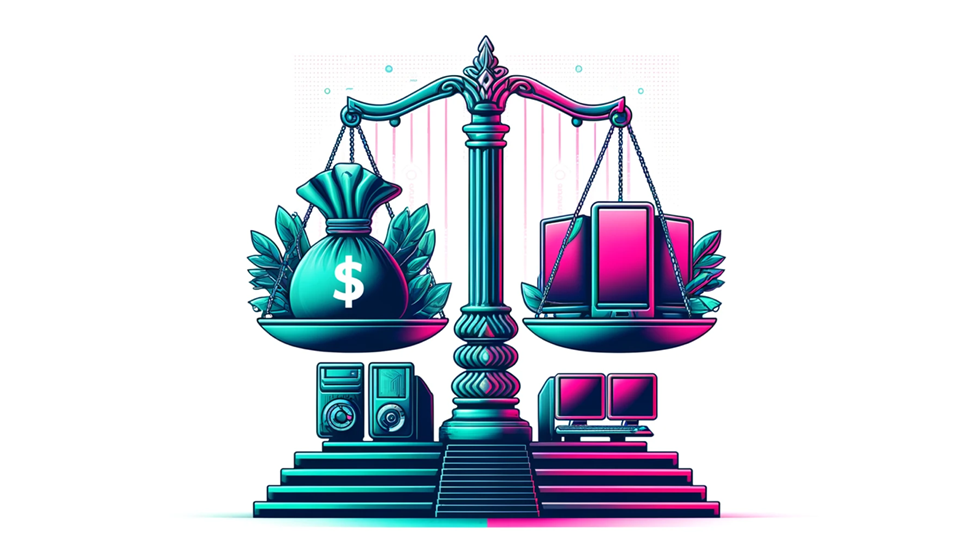Show Me The Money: Building a Profitable eDiscovery Cost Recovery Model
In the beginning, there was paper and lots of it.
Think stacks of bankers' boxes big enough to make an entire mountain out of. But the all-too-familiar buzz of a dial-up modem ushered in a brave new world for the discovery process and litigation as a whole.
With the 2006 amendments to the Federal Rules of Civil Procedure, an entirely new, now multi-billion dollar industry was born. Prior to adding the term electronic documents, discovery was more about paper, cuts, banker, boxes, and beat stamps. With the advent of this new industry came new and fascinating questions that we grapple with to this day.
Many law firms found themselves with a bit of a quandary. Should we consider this eDiscovery stuff to just be an IT cost for doing business? Or is this a new potentially profitable area of practice?
18 years later, the debate around cost recovery and building a profitable eDiscovery program has not abate. This blog breaks down the flavors of cost recovery available for eDiscovery program directors today. As well as the benefits and opportunities posed. Providing a framework to determine if and how you want your eDiscovery program to “show you the money.”

What is Cost Recovery?
When firms initially scrambled to handle the increasing volume of electronically stored information (ESI) in the discovery process, they took many differing routes regarding the cost of the software and the human talent necessary to deliver.
What is cost recovery? It is the process of law firms apportioning technology and other costs back to their clients.
Some outside counsel guidelines stipulate that costs related to information technology should be absorbed in the cost of doing business. Others allow certain specialized services and technology to be billed back at a straight pass-through or potentially even with some level of profit margin baked in.
Another factor in building out a cost recovery model is whether or not the discovery technology and professionals are an in-house resource or being outsourced to an alternative legal service provider. Because software and document review costs can run in the millions on a large litigation, how one engages with the service providers and software companies has a major impact on overall cost and approach to recovery.
According to a recent cost recovery report by Epiq, factors including geography, matter type, client makeup, and logical regulation can all factor into the position of cost recovery.

Flavors of Cost Recovery
This different approach has led to different flavors of cost recovery models across each law firm today; here are a few:
Sunk Cost- Cost Center
Some organizations draw the line between software or technology and human capital. They take the outside counsel guidelines relating to charging for information technology to heart. Viewing eDiscovery software, and cost associated on the technology side as falling under that same umbrella. You often will see this in smaller firms or ones that perhaps do not have a massive litigation portfolio. Increasingly, the cost associated with e-discovery and its broader application to a much more diverse type of matter has shifted firms out of favor in this approach.
Straight Pass-Thru
For law firms with managed service relationships with an ALSP or who have a robust outsourced e-discovery cost, a straight pass-through method may make sense.
Pricing for discovery, technology, and litigation support services can be a substantial line item on a litigation bill. Using a straight pass-through approach is a middle ground firms embrace to ensure they are not losing money on discovery-related costs.
In this instance, the bills for hosting data, any services engaged with an outside legal service provider, and or a document review attorney cost are all consolidated. Often broken down on a matter by matter, basis and reverted as part of the billing on specific litigation.
For some organizations who infrequently deal with electronic discovery, or who, primarily outsource, this can be a reasonable approach. Ensuring they aren't losing money on expensive eDiscovery services.
Profit Center
For law firms with an in-house team of electronic discovery experts, litigation support professionals, and on-premises or cloud-based dedicated software, treating discovery like a profit center makes more sense.
At the top global law firm I worked at, we took an approach of charging billable hours for internal litigation support professionals on a case-by-case basis, as well as a hosting cost per gigabyte per month per matter. This enables us to recover the cost associated with software, licensing, and hardware necessary to support it.
Other organizations may employ a cost recovery model that looks more similar to traditional discovery ALSP pricing. Incorporating license fees per gigabyte, hosting, analytic cost, and personnel time.
Some law firms have created practice areas around being an eDiscovery Council. In this case, cost recovery is combined with the traditional billable hour for attorneys in the practice group. Some of these in-house practice areas function almost like a captive legal service provider, often rivaling LSPs in size and profitability.

To Pay or Not to Pay
The data volumes and the frequency of discovery has increased over the years; the cost of eDiscovery technology and talent has grown as well. As a result, many organizations that initially had a sunk-cost approach to eDiscovery cost recovery have had a change of heart.
why might an organization that has not previously charged for discovery want to shift to a profit center cost recovery model?
Best in Breed Tech
As the way that humans live, work, and play has become increasingly digital, lawyers, increasingly need ways to effectively uncover facts in ESI. As the volumes of data have become larger and more complex, having the best of breed and AI-powered eDiscovery technology is a need to have. Not just a nice to have.
Creating a cost recovery model allows firms to continue to invest in the, at times, costly best-of-breed technology. Without having it hit the bottom line and while increasing overall firm profits.
As business models and personal lives are increasingly data-driven, having the best discovery technology is critical. Simply eating the cost of what can be pricey licenses is not always feasible or the best option.
Buying Power
For law firms with a large enough litigation portfolio, the potential cost savings for discovery expenses at scale is important. Being able to engage with eDiscovery platforms at larger dollar volumes often equates to a lower per-unit cost.
Engaging with project management personnel that are internal resources can serve as quite the cost savings. Especially when compared to engaging on an hourly level with a legal service provider’s talent. Discovery services will always be a large line item for a law firm, but larger multi-year licenses and internal resources may make your buying power go further.
Alignment with Firm Objectives
It is no surprise that an outsourced partner may not have the same objective as a law firm that is engaging them. Both organizations have business models predicated on profitability and revenue streams.
If you have internal resources that you are leveraging and recovering cost on, those resources are driven by the objective to be as efficient as possible. Reducing cost on a per unit and per matter basis. Whereas the outsourced partner may have an incentive to bill more hours or collect and process more data.

Be Goldilocks - Make it Just Right.
When it comes to building an effective and profitable eDiscovery program, there is no one size fits all. Factors to consider when evaluating which approach makes sense for you include:
Litigation portfolio composition: What is the size, scale, complexity, and geography of matters that your firm handles? If you are primarily handling small but high-volume matters, having an internal resource that you can pass through makes more sense than trying to spin up dozens or hundreds of matters with a legal service provider.
If you often deal with highly technical and atypical data types, partnering with a legal service provider may make more sense. If every case is up at the farm one to the tune of terabytes of data, you have a good case to either build a profit center or handle discovery as a pass-through.
Client Composition - Understanding of your client's appetite also makes sense. If you are in the Northeast and your clients are primarily highly regulated pharmaceutical or financial service organizations, they are likely more accustomed to a cost recovery model. And less likely to push back on a bill, reflecting cost relating to data, hosting, and hours of litigation support services.
If, however, you are, perhaps, in the Midwest with a client base that is more small and medium business and less accustomed to paying for these services, you may see more pushback on attempts to recoup costs associate with eDiscovery.
Your Organization - in evaluating which cost recovery approach makes the best sense for your organization. Taking account of your organization is critically important. Are you a large enough law firm to have dedicated electronic discovery resources and to merit signing a license for eDiscovery software? Do the types of cases and issues at stake merit. Bringing those resources in house? Does your firm have the risk appetite to make these investments on the potential of profit down the road. How does your organization look at technology in general?
Are they embracing technology as a force multiplier, or do they simply look at it as a line item to be deducted from PPP? Understanding all of these factors are key in determining your cost recovery approach.
Rules & A Reasonable Approach
Since the initial amendments back in 2006, we have had 18 years of caselaw and further amendments that help pave the way for cost recovery as more of the de facto norm. Reasonableness is a key factor in determining whether a firms attempt at cost recovery is appropriate.
The questions you should ask yourself in building out your cost recovery approach are the same that a litigator or jurist would ask in evaluating proposed bills for eDiscovery services.
Namely:
- Are law firm cost recovery fees reasonable in relation to their expense?
- Were they well explained to the client?
- Did the technology used to reduce overall cost?
- Is the eDiscovery technology and personnel cost proportionate to the amount at issue?

Client Better Have my Money!
When building out your E discovery program, questions around in-house versus outsource are a first stop on determining your cost recovery approach. You also want to look at the composition of your litigation portfolio. And the appetite of your firm to invest in technology and personnel necessary to support and eDiscovery program.
If you have internal resources having an effective way to recoup the cost associated is critical. Understanding the different levers you can use in a cost. Recovery model is important as you build up and build out your program.
Outsourcing legal tech can make a lot of sense if you are looking for a force multiplier. And if you do not have the internal resources. But if your legal teams have the appetite, direct subscriptions with software providers and internal in-house resources can drive down total eDiscovery cost and greatly increase law firm revenue streams relating to discovery.

